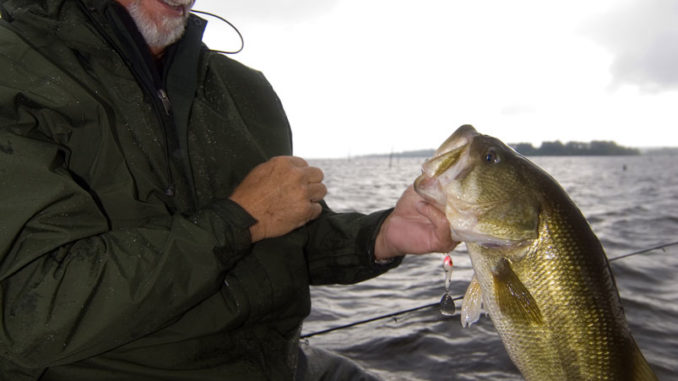
Wait for a warming trend and look for bass moving deep to shallow
When you’re thinking about all the time you expect to spend indoors this winter, why not include some time to get out for a day or so of fishing? There may be no better place to go in North Carolina than Lake Gaston, where you have opportunities to catch all three major species of black bass — largemouth, smallmouth and spotted bass — along with striped bass, walleye or crappie using the same techniques.
Gaston, which covers 20,000 along the North Carolina-Virginia border an hour’s drive northeast of Raleigh, is one of the state’s most-underrated lakes these days. Fishing pressure is relatively low, especially in the winter, when there will be very little, if any, pleasure boat traffic.
So how do you pick when to head for the water once winter approaches and a warm spot in front of the fire keeps many fishermen occupied? According to a handful of veteran fishermen who are familiar with Gaston, the best fishing takes place after a warming trend that lasts a few days, when the sun can warm shoreline rocks and raise water temperatures. A change of a few degrees in surface temperature can lead to a big increase in fishing success.
And it doesn’t matter whether you prefer shallow, mid-depth or deep-water fishing, options for all three exist. In addition to many other parts of the lake, you’ll find places to try all three behind the first bridge across Pea Hill Creek. As the water cools into December, look for birds circling and other fishermen to get an idea where the fish are hanging out. There’s no need to crowd anyone, as you might find a better group of fish on another spot several hundred yards away. Idle around, watch your fish locator and start fishing where you see groups of good arches and bait schools near the bottom.
Chuck Murray, the retired finance director for nearby Franklin County and president of the N.C. Bass Federation, likes both the upper and lower ends, depending on conditions, but he said covering a “bunch of water” is important for winter anglers.
“When there’s current, I like to fish rock piles up toward the river,” he said, recommending a 1/2-ounce football jig in 12 to 20 feet of water, or 1-ounce if you’re fishing deeper, say, 18 to 25 feet. Most of the time, up in the river section of the lake, the water will be more stained, and he’ll fish a black/blue color combo. In clearer water, he goes for an “Okeechobee craw” color.
If there’s no current being generated through either Gaston Dam downstream or Kerr Dam upstream, Murray goes for jerkbaits in clearer water on the lower end of the lake. “On warmer days, use a small crankbait on long points at mouths of creeks near the dam in 7- to 8-foot depths.”
In cloudy weather, Murray likes a jerkbait with a black back and silver sides; on bright, sunny days, he goes with a green-backed bait. Some of his best fish, he said, have been caught on a “jerkbait near the dam in clearer water, a jig upriver or a small crankbait if it warms up.” He’s always on the lookout for “cleaner, warmer water.”
J.T. Palmore, a former bass pro from Blackstone, Va., who guides on Lake Gaston, targets several different kinds of structure or cover with several different lures.
“You can always catch fish on a shaky head worm worked around brush piles or rock,” said Palmore, who said that any aquatic grass that might be found alive will normally be holding bass. .
He also recommends an Alabama rig and said that there’s “no better wintertime bait in clear water.”
Palmore prefers his Alabama rigs to contain Fluke Jr. in white or albino shad, saying that some other brands “don’t last as long; you catch one fish and then have to throw them away.
“Use your GPS and lake maps to find areas that go deep to shallow in a short distance,” he said. “Bass don’t like to expend much effort to adjust to pressure changes from passing weather systems.”
He likes creeks where the water drops quickly off points, where there’s easy access to deep water and where a difference of one boat length can mean going from 5- to 28-feet deep.
“On warm days, they’ll head up shallow to sun, especially around rocky banks that hold heat,” he said. “Or they may lay on a muddy bottom; you can tell by mud on their stomachs.”
Creeks on the northern side of the lake catch more sunlight during the winter and warm up more quickly, and Palmore prefers to stay in those creeks to stay away from main-lake current and look for bait. He likes to fish a football jig around bridge pilings and riprap and a MegaBass Vision 110 jerkbait. His favorite colors at Gaston are clear and silver sides/green back/purple bottom.
Jeffrey Thomas of Broadway, a former touring pro, said that Gaston has always been one of his favorite lakes — “I cut my teeth here,” he said.
Thomas likes to fish on the tail end of warming weather is a key.
“Throw a spinnerbait on windy rocks in the winter,” said Thomas, who looks for wind-blown riprap in front of houses and around bridges. “The bigger bass stage on an early warming trend.”
Although they’re getting harder and harder to find, he likes a Hawg Caller spinnerbait with double willow-leaf blades, an “R” bend in the wire and a white skirt.
Thomas also likes to target docks that have deep water in front of them, and culverts under causeways. He likes to fish the first riprap off the main lake in Lizard, Songbird and Six Pound creeks. He also likes the lake’s growing population of spotted bass.
“They are aggressive in cold water and show up more in winter on Gaston, especially when throwing a spinnerbait like I do,” said Thomas, who thinks Lizard Creek has the best population of spots in the lake. “There is a better population of spots in Gaston than most (anglers) know.”
When bass are deep in summer or winter, blade baits — the most famous is a Silver Buddy — can be good choices. Look for fish hanging around deep drops and along outside creek bends. They can be hopped off the bottom in quick jumps of a foot or so. If you see fish on your depth finder and feel your bait getting swatted at, keep aggravating them until one loads on. Jerkbaits that of the deeper-diving variety are another excellent choice when fishing rocky banks. Don’t forget to tune your jerkbaits by bending the line tie just like you would any crankbait to get the best depth and action.
So if you need an excuse to leave the recliner and turn off the football game, look at the weather forecast for a slight warming trend, pack your gear and head north to the border.
DESTINATION INFORMATION
HOW TO GET THERE — Lake Gaston, a Roanoke River reservoir, straddles the border between North Carolina and Virginia an hour or so northeast of Raleigh. The lake is ringed in public boat landings. A number of landings in North Carolina are accessed off US 158. See www.ncwildlife.org/Boating/WheretoBoat.aspx. On the Virginia side, take the Bracey Exit 4 off I-85 and head east on VA 903 to Holly Grove Marina and Poplar Creek.
TECHNIQUES/BAITS — During the winter, jigs, spinnerbaits, jerkbaits and blade baits fished around rocky or riprapped banks after warming trends lasting a few days. For jerkbaits, use a 6-foot-8, medium-action baitcasting or spinning rod and reel with a light tip. Spool the reel with 10- to 12-pound line. Spinning tackle is nice when casting small baits in the wind. For blade baits, a 6-foot-10 worm rod and baitcasting reel spooled with 15-pound line. Use a ball-bearing swivel to prevent line twist. Fluorocarbone line provides better sensitivity due to reduced stretch, but knot problems and related line breakage are concerns.
FISHING INFO/GUIDES — Chuck Murray, Chuck Murray Outdoors, Louisburg, 919-495-5466; J.T. Palmore, Lake Gaston Pro Guide Service, Blacksburg, Va., 804-586-7645. See also Guides and Charters in Classifieds.
ACCOMMODATIONS — Hampton Inn, South Hill, Va., 434-447-4600; Halifax County Convention and Visitors Bureau, Roanoke Rapids, 800-522-4282, www.visithalifax.com. Camping is available year-round at Lake Gaston Americamps, Bracey, Va., 434-636-2668.
MAPS — GMCO Maps, 888-420-6277, www.gmcomaps.com; Fishing Hot Spots, 800-ALL-MAPS, www.fishinghotspots.com.

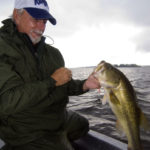
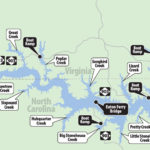
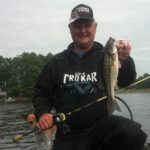
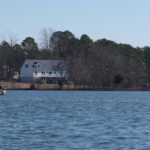


Be the first to comment